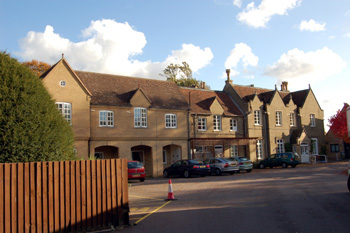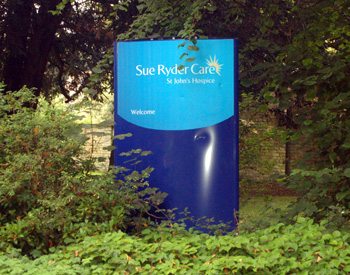
Saint John's Hospice October 2009
It is interesting that the two largest private houses in Mogerhanger were both used for medical purposes in the 20th century. Mogerhanger House was a sanatorium for over sixty years whilst Saint John's House has been turned into a hospice. Whereas Mogerhanger House had little or nothing added by way of additional buildings, Saint John's House has had a considerable amount of addition for its new role.
Saint John's House, officially 63 Saint John's Road, was built in the 19th century for Colonel William Thornton, later Lord of the Manor, who died in 1864. In James Horsford's obituary of 1887 it states that "designed Colonel Thornton's mansion at Morhanger". The house was almost certainly built between 1850 and 1853 (whilst Godfrey Thornton was still Lord of the Manor). In 1850 William Thornton took out a mortgage for £1,492/6/5 with Henry and Augustus Vigne of Paddington [Middlesex] [X612/82]. This loan was secured on a farmhouse, with land of 139 acres, 21 poles, a cottage and shop and ten cottages in Mogerhanger. This mortgage is endorsed with a further loan of £731/11/10 in 1853 which notes that Thornton had built a dwelling house on part of the mortgaged land, the clear implication being that this is Saint John's House. The additional money was probably to cover the cost of building the house. Thornton had purchased all this land in 1850 from the trustees of the will of Samuel Sutton [X612/121a-b].
The Rating and Valuation Act of 1925 specified that every piece of land and building in the country should be assessed to determine the rates to be paid on it. Blunham was assessed in 1927 and the valuer visiting Saint John's House [DV1/R47/74] noted that it was owned by Brigadier-General William B. Thornton, a member of the family which had been Lords of the Manor from 1777 to the late 19th century.
The house comprised a hall ("hall and stairs very poor"), a dining room measuring 20 feet by 17 feet, with a bay ("good"), a drawing room measuring 16 feet by 23½ feet ("very nice"), a study with two windows ("nice"), a store, china cupboard, silver pantry, housemaid's cupboard, larder ("small"), boot room, kitchen ("small"), scullery, bolier room, servants' hall, cellar and W. C. ("all very convenient") downstairs. Upstairs lay a south-east bedroom over the dining room measuring 20 feet by 17 feet, a dressing room, a bedroom over part of the drawing room ("good"), with a dressing room ("tiny"), a single bedroom, a bathroom, a W. C., a small bed or play room, a servant's bedroom, two smaller servants' bedrooms and back stairs (for the servants). The attic contained a narrow boxroom.
Outside stood a brick and tile servants' W. C., and another W. C. for the gardener (who had a separate house - now 65 Saint John's Road). There were also a brick and tile coal shed and a brick and corrugated iron potting shed and store. Other outbuildings comprised: a wood and tile hen house; an electric light plant; a brick and tile range comprising three unused loose boxes, a harness room used as a store and a man's room over used as an apple store and two garages ("good).
The grounds included a tennis court ("good") and a drive up to the house. This latter was "only fair". The valuer considered the house stood in a "Bad social position" and reckoned it was "worth the same as Blunham Grange" but was "much more attractive". He commented: "Saw Brigadier-General Thornton. Radiators. Electric Light. Water laid on. House well arranged".

Sign for Saint John's Hospice
In the latter part of the 20th century the house was bought by Sue Ryder Care and is now [2009] a hospice offering short-term palliative care for fifteen patients with conditions such as Cancer, Motor Neurone Disease, Multiple Sclerosis, heart, liver and lung failure. Treatments such as blood transfusion and complex drug administration are undertaken and a specialist in Lymphoedema works on the premises. Interestingly, in a short article on the hospice in the newsletter of Dunstable Rural Deanery in 1984 [AB/RD/D13/30] it was noted that one of the people instrumental in helping Sue Ryder set up at Mogerhanger was John Hare, Bishop of Bedford from 1968 to 1976.